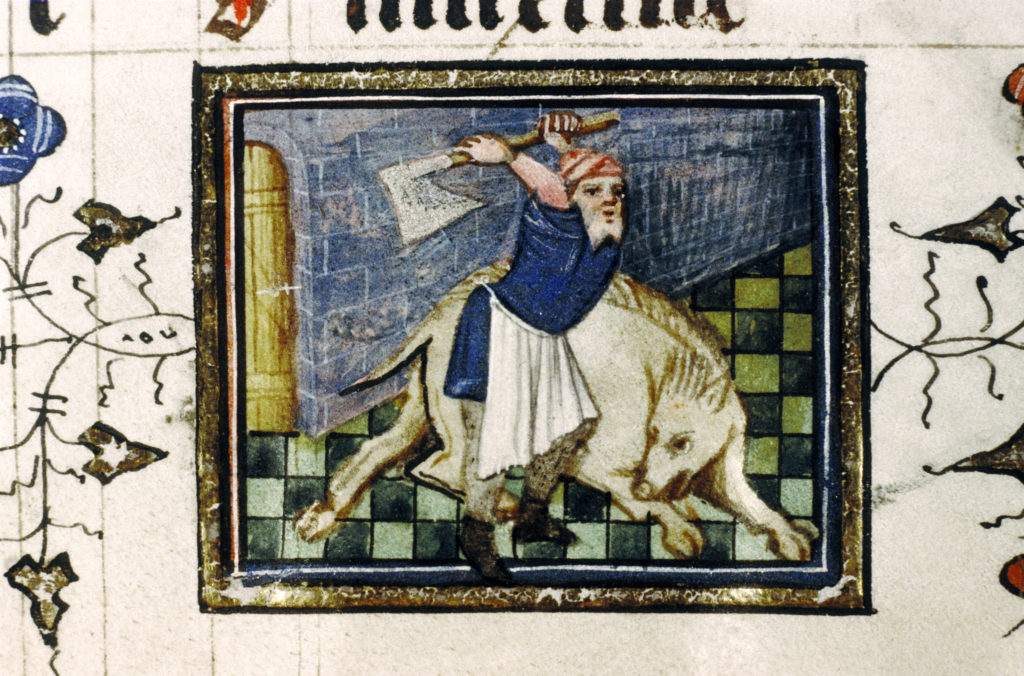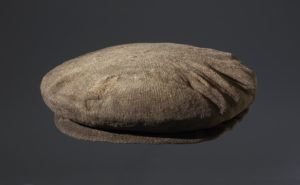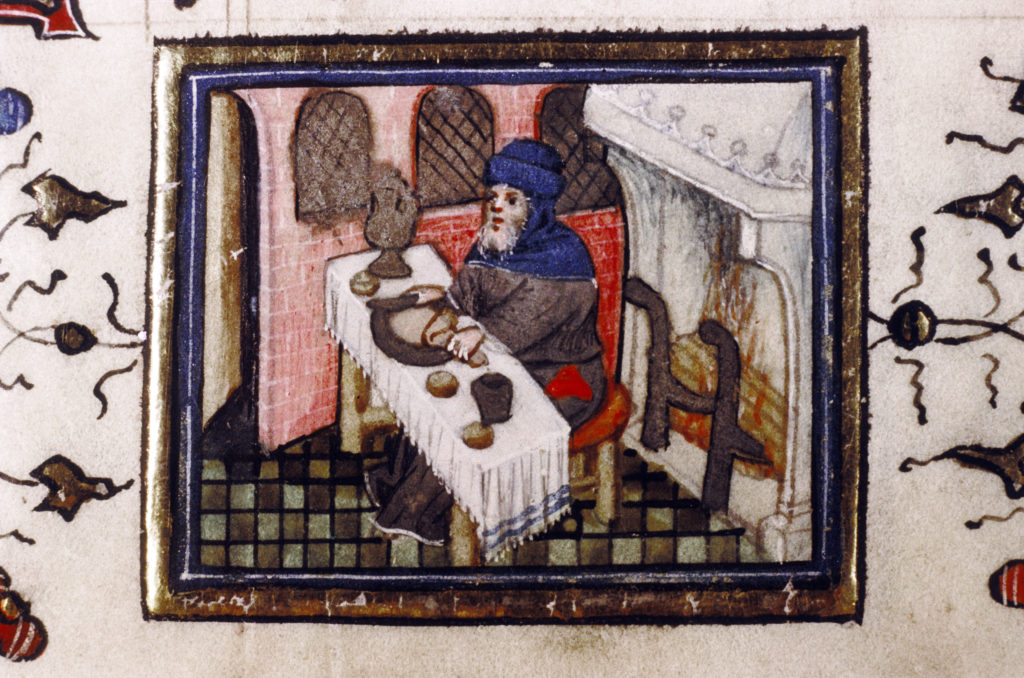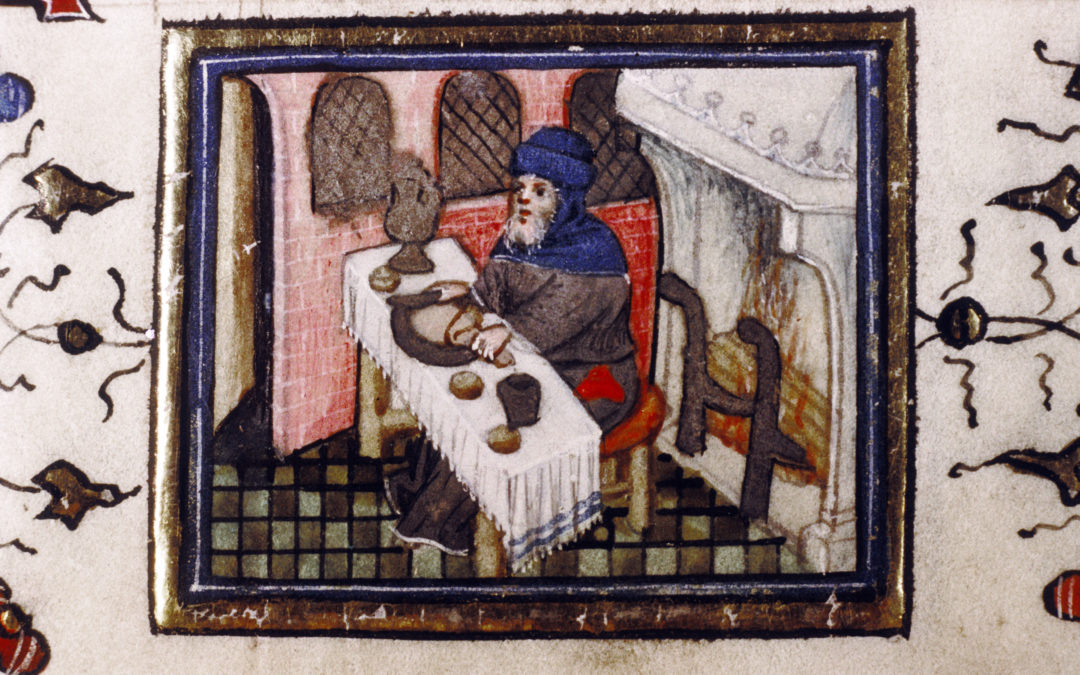By James Davis, Catherine Casson and John Lee
Environment & History, essay no. 2
In the second part of our ‘Environment & History’ series, historians James Davis, Catherine Casson and John Lee share their research on the re-circulation of waste and by-products in medieval England. This forms part of a unique trans-disciplinary collaboration between medieval historians and academics in the field of sustainability. Their historical case studies examine the three elements of reuse, repair, and recycling, emphasise the significance of institutional policies towards waste management, and thereby help to inform current models of transformational environmental change.
The next essay in the ‘Environment & History’ series will be added on Wednesday 10 February 2021 with ‘Hydropower & Salmon: Historical Case-studies for Modern-day Problem Solving’.
The circular economy
Contemporary environmental concerns about the consumption of finite resources and the production of waste have led to the concept of a circular economy. In this model, processes, products, and systems are designed to keep resources in use for as long as possible in order to extract their maximum value, eliminate waste, and then recover and regenerate these materials.
We are examining the circulation of waste in medieval crafts, identifying practices of recycling, repair, reuse, and upcycling, as well as discovering networks of waste management through crafts working together to use the by-products of others. While modern-day models of upcycling and sustainability are inspiring our work, we are also sharing our evidence for the re-circulation of waste and by-products in medieval England with academic researchers in sustainable consumption, Professor Frank Boons, Dr Helen Holmes, and Harald Wieser at the University of Manchester. By working with these specialists in consumption and the circular economy we are hoping to reach a wider audience.
Academic research in the field of sustainable consumption has rarely utilised historical data and generally considers each element of reuse, repair, and recycling in isolation. It tends to focus on the role of consumers in making decisions. Our research from the Middle Ages examines all three elements of reuse, repair, and recycling, and highlights the key role of institutional policies in both promoting and discouraging more sustainable waste management.

Butcher killing pig. Oxford, Bodleian Library MS. Rawl. liturg. e. 14, f. 16r, Book of Hours. © Bodleian Libraries, University of Oxford. CC-BY-NC 4.0. Available via Digital Bodleian.
Butcher, baker, candle maker
The medieval butcher probably supplied over twenty-five specialist trades that produced a range of commodities; from bottles and boots, to gloves and saddles. After their prime cuts were sold from designated stalls and shops, butchers’ off-cuts of meat ended up in pies and pastries. Little of the rest of an animal was wasted, and the importance of the whole carcass was reinforced by institutional ordinances that prohibited butchers from separating the skin and horns before coming to market, like those of Leicester in 1467:
‘every bocher of the cuntray that bryng flesshe to the market [shall] bryng the skynnes and talowe of the same flesshe with hem in payne of forfetyng thereoff.’
The hides and skins of animals went to local tanners and skinners, who would then supply shoemakers, saddlers, and others. Tallow was acquired by those who made candles for everyday use, as opposed to the more expensive wax variety produced exclusively by chandlers; tallow was also purchased by soap makers. There was a fine line between legitimate by-products and fraud, with regular offences in Exeter for those who used inferior fats in their candles.
The inter-relations between crafts led to the spatial clustering of urban occupations, as at Winchester, where chandlers’ workshops were conveniently located on the butchers’ route to offal pits. The bones of animals could be boiled for glue, while horns were carved for drinking vessels, combs, needles, lantern leaves and spectacles. Many of these products were those in increasing demand as standards of living and disposable income rose after the Black Death.
From rags to riches
Our research is revealing similar circulations within the English textile industry of recycling, reuse, and repair, together with inter-craft networks of waste management. There was an active market for second-hand clothes and fabrics, and dealers known as ‘upholders’, fripperers, or ‘phelipers’ can be identified in several medieval English towns including London, Coventry, Norwich, and Nottingham. Botchers re-made garments from old ones. One preacher, the Franciscan friar Nicholas Bozon (fl. c.1320) even used a repairer of old clothes as an analogy for Judgement Day:
‘the simple folk will be exalted for their good deeds and the haughty abused for their pride. Then God will do as the mender of old clothes, who turns the lappet to the front and what was uppermost, downwards.’
With materials expensive and production labour-intensive, little was wasted. Most textiles must have been re-cut and reused until they were finally discarded as worn-out rags or latrine-wipes.
The textile industry’s waste products were coarse tufts and wool offcasts, removed before spinning, known as flocks; the unwoven ends of the warp threads left on the loom, and other pieces of waste thread or yarn after weaving, termed thrums; and shearings cut from the cloth, also called flocks. These waste products were put to three main uses: stuffing and quilting; hat and cap making, and cloth making.
Flocks were used for stuffing beds, cushions, and mattresses, and could be bought for this purpose. The bursars of Durham Cathedral Priory, for example, bought flocks for repairing cushions in one of the prior’s chambers in 1335/6, and paid 16d. for flocks to fill saddles around 1343. Complaints were voiced when these fillings were deceptively mixed or substituted, like the claims made by the Worshipful Company of Upholders in London in 1474 of
‘Featherbeds and bolsters stuffed with feathers and flocks, pillows of down stuffed with thistle down and cats tails, mattresses stuffed with hair and flocks and sold for flocks, mattresses of netish [bovine] hair and horse hair which is called tanners’ hair, jacks [stuffed or quilted tunic] made with rotten cloth and painted clothes of old woollen cloth, cushions stuffed with hair and sold for flocks.’
As a consequence of this petition, the city authorities in London granted the wardens of this guild the power to search for these wares across the city and seize all wares that were insufficiently or not truly made. National legislation followed with an act of 1552 specifying that beds were to be stuffed only with dry feathers or down, and no quilt mattresses or cushions were to be sold that had been stuffed with anything except feathers, wool, or flocks alone. This fraud was not confined to the medieval period, and even in the twentieth century, it was necessary to introduce parliamentary legislation to prescribe filling materials and standards of cleanliness, including the Rag Flock and Other Filling Materials Acts of 1951 and 1981.
Although thrums were off-cuts or waste threads, they were of sufficient value to be exported and recorded in the customs accounts. For example, in 1390/1, four ships left Boston, Lincolnshire, with cargoes including thrums, mostly taken by foreign merchants. Thrums were knitted into caps, and thirty-five dozen ‘thrumhattes’ were imported into Hull by the Anne of Hull in April 1453. Thrums were also used for mops, like those bought in 1466 for the household of Sir John Howard, first duke of Norfolk, to apply pitch to the side of a boat.
Felting was a way of using up waste material from the textile industry including flocks and clippings. Urban authorities, however, repeatedly rejected the use of flocks in felt caps. Representatives of the craft of cappers complained to the mayor and aldermen of London in 1311 that caps were being imported from abroad made of flocks mixed with wool. In Coventry in 1515, it was ordered:
‘that no capper in this city from henceforth flock any cap and so utter (sell) it, upon the pain to forfeit the caps so flocked, and the said caps burnt, and over that for every cap so found faulty and burnt to forfeit 4d…’
Flocks and thrums were also used in cloth-making, including adding to the yarn, and to the cloth during fulling. Guilds, urban authorities, and central government, however, sought to limit the use of flocks in cloth-making. It was feared that utilising flocks and thrums damaged quality and unfairly undercut the production costs of other manufacturers. Several towns, including London, Bristol, and Coventry, had draconian regulations for cloths produced using flocks or thrums. Bristol weavers, for example, were warned that if any cloth was found made of thrums, the cloth, and the instrument on which it was worked on, were to be burnt. These urban regulations were mirrored by national legislation, such as that of 1464 which stated that no person making any woollen cloth, ‘shall mingle or put in or upon the same cloth, nor into the wool whereof the said cloth shall be made, any lambs wool, flocks, tallow or cork’. Exemptions were made, however, following a petition to Parliament, for cloths produced in parts of Devon and Cornwall, which used coarser wool, to include flocks in their manufacture.

Cap, fulled and felted, mid-sixteenth century. British Museum, Museum number 1856,0701.1882 © The Trustees of the British Museum. (CC BY-NC-SA 4.0).
Quality control and consumption
As we have shown, guilds and urban authorities frequently restricted the extent to which craftsmen could innovate and even reuse materials. The close supervision of manufacturing practices and attempts to standardise these practices through the appointment of searchers, together with other regulations on quality, may have encouraged the linear movement of materials rather than their circulation, since they favoured new goods over reuse as a means to protect standards. We see this in the strict rules applied to late medieval cordwainers, who were not to use any old leather in their shoes, and for furriers in London who were forbidden from buying or selling second-hand furs. In York, any skinner who mixed old with new skins would have his product burned in the middle of the street as an example.
Consumer protection was another motivation for regulation. There were concerns that the use of waste materials from production could be used to defraud customers, by substituting inferior quality material for superior quality material. Waste material was often associated more with old, worn, or defective materials, rather than with, for example, off-cuts. Some professions did attempt to exploit consumers by, for example, mixing old and new materials and passing the finished product off as new. But the regulations also made it difficult for shoemakers, for example, to use up several different off-cuts of leather to create a shoe.
The capacity of institutions to restrict the reuse of materials was limited though, particularly when the market for products was widening. The Black Death of 1348-53 had led to a significant increase in material living standards for those who survived. Recent research has suggested that within half a century of this catastrophic pandemic, the average income in England increased by almost 50%. The late fourteenth and fifteenth centuries saw growing demand for small consumables, many of which were cheaply made and finished, and we can speculate that they were ideal for using up scraps and defective materials. Cheap metal pilgrim badges (pewter or lead) were produced in their thousands and were a growth trade of the fifteenth century. Felt caps were increasingly popular by the mid-fifteenth century and made of compact wool bits; to this could also be added bits of fur or hair, not necessarily legitimately.
Repair and reuse also became more acceptable as the Middle Ages progressed. Customers were often involved in the process, providing items from their household to be repaired, reused, or upcycled. The development of shoes with two-piece soles in the late fourteenth century made repair and reuse easier for cobblers, while many shoes in the fifteenth century incorporated heel stiffeners, which could be derived from scrap materials. Metalworkers, as expected, would often melt down old products for reuse. For instance, we know that silver was often given by customers to silversmiths or goldsmiths in the form of old plate or coins, and most silver spoons were made in this way. Pewterers accepted pewter scraps as part-payment for new products. The wills of fifteenth-century London brasiers show large stocks of old metal and brass, probably off-cuts waiting to be melted down, as well as hammers for breaking up scrap. The later fifteenth century saw a rise in demand, particularly from urban consumers, for small, low-cost brasses as a cheap and popular form of commemoration. Discarded pieces of memorial brasses, which used latten plate, could be re-engraved on the reverse without disfigurement. The inscription to Robert Symson, master of the hospital of St James near Northallerton, was erroneously engraved as ‘Northampton’ in 1497, but reused just five years later by reversing the plate to provide an inscription to yeoman William Pope in the church of Cowley, Middlesex. Wills provide occasional hints at the circulation of manufacturing materials. In Ipswich, for instance, in 1473, Alice Andrew requested that all her brass and latten should be melted down for the new bell at the church of St Mary at the Quay.
In a medieval urban society, where raw materials could be relatively expensive and profit margins tight, the re-employment of scraps and by-products was an essential part of craft strategy. The circulation of by-products also had an environment impact in terms of reducing their urban footprint. The greater the level of circulation, the lower the overall use of materials and energy for a given number of outputs. Medieval artisans were seemingly well aware of the potential value of their industrial ‘waste’. This affected the location, coordination, resourcing, and costs of their crafts, and how they responded to changes in consumer demand. Certain crafts/trades grew due to these established patterns and networks of medieval waste management. Institutions were not always supportive of attempts to reuse and recycle materials, but medieval craftsmen found means to circumvent these restrictions and supply growing consumer demand. As modern consumers, manufacturers, and governments seek to increase the reuse, repair, and recycling of commodities, there is much that we can learn from the medieval economy.

Medieval consumption – feasting beside a fireplace with fine tableware and table linen. Oxford, Bodleian Library MS. Rawl. liturg. e. 14, f. 5r. Bodleian Libraries, University of Oxford. © Bodleian Libraries, University of Oxford. CC-BY-NC 4.0. Available via Digital Bodleian. This image was also used for the blog-post header.
***
Dr James Davis is a Reader in the School of History, Anthropology, Philosophy and Politics at Queen’s University Belfast and author of Medieval Market Morality: Life, Law and Ethics in the English Marketplace, 1200-1500 (Cambridge, 2012).
Dr Catherine Casson is a Lecturer at the Alliance Manchester Business School at the University of Manchester and author of The Entrepreneur in History: From Medieval Merchant to Modern Business Leader (Basingstoke, 2013).
Dr John Lee is a Research Associate at the Centre for Medieval Studies at the University of York and author of The Medieval Clothier (Woodbridge, 2018).

